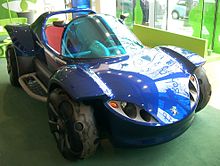Prototype - Simple English Wikipedia, the free encyclopedia
A prototype is an original type, form, or instance of something. (usually in engineering) It serves as a typical example or standard for things of the same category. Some prototypes are used to find defects or to test an idea. Building a prototype of each idea and testing them is a good way to choose a final design.
Different kinds
[change | change source]
Prototypes are built for different reasons:[1]
- Proof of principle prototype (or model): Shows that something can be done. These kinds of prototypes are built to test a part of the design. These prototypes do not look like the finished product, in most cases. Such prototypes are used to show that certain design choices will work or will not work.[2]
- Form-study prototype (model): This tries to show what the finished design will look like, but without the function. Such prototypes allow to take decisions about the exact shape, size, or ergonomic properties. This lets a designer see if things fit together, and will feel right.
- Visual prototype: These will look like the actual product, and are used for market research. They do not have any of the functionality of the final product. An example is a concept car at a car show. It may look like a new car but may not even have an engine.[3]
- User experience prototype represents enough of the appearance and function of the product that it can be used for user research.[4]
- Functional prototype: These will behave and act like the final product as much as possible. For cost reasons, they may be smaller in size, or they may not have the final look of the product.[5]
- Paper prototype is a printed or hand-drawn representation of the user interface of a software product. Such prototypes are commonly used for early testing of a software design, and can be part of a software walkthrough to confirm design decisions before more costly levels of design effort are expended.[6]
Manufacturing Process
[change | change source]Prototyping typically begins with a digital 3D model, which is transformed into a physical prototype using processes like 3D printing, CNC machining, or vacuum casting. The chosen method depends on the material, complexity, and intended use of the prototype. After manufacturing, prototypes undergo testing and evaluation for functionality, fit, and design accuracy. This iterative process allows for fast modifications, enabling efficient refinement and validation before committing to large-scale production.[7]
References
[change | change source]- ↑ Lai, Chun Sing; Locatelli, Giorgio (February 2021). "Valuing the option to prototype: A case study with Generation Integrated Energy Storage". Energy. 217: 119290. doi:10.1016/j.energy.2020.119290.
- ↑ "Proof-of-Principle Prototype". 3d-printing-expert.com. Retrieved 2019-12-15.
- ↑ "What Is A Visual Prototype". 3d-printing-expert.com. Retrieved 2019-12-15.
- ↑ "Prototyping services". Retrieved 2020-02-25.
- ↑ "Prototypes: General Categories". ThomasNet. Archived from the original on 16 January 2017. Retrieved 13 July 2015.
- ↑ "Prototyping". Brown University - User Experience, Independent Study Project. Retrieved 2015-02-24.
- ↑ Michael (2021-05-07). "Introduction of Rapid Prototyping". RpProto. Retrieved 2024-11-07.


 French
French Deutsch
Deutsch